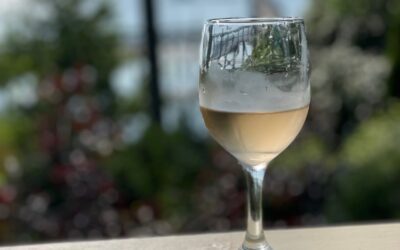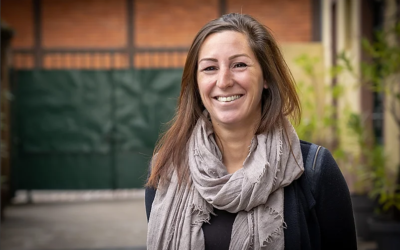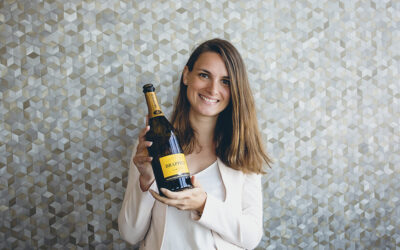A Tête-à-Tête with Olivier Krug, sixth generation director of La Maison Krug
Wine, in its very essence, is one of the great simple pleasures of life. Yet for a drink that is the epitome of hedonism, wine, ironically, can be quite daunting. Everything from the mystical terminology, old school wine tasting protocol, formal serving etiquette to the theatre of uncorking a bottle, not to mention the pervading wine snobbery culture associated with the biblical beverage comes off as pretentiously too intellectual and technical. And among all wine categories, Champagne certainly ranks as one the most overwhelmingly enigmatic and complex varieties.
Yet, amid the brouhaha, one incorrigibly defiant man is challenging the norm, debunking this widely held preconceived belief that champagne is intimidating. Complex but not complicated argues Olivier Krug, the sixth generation of the Krug family and Director of the Maison, who believes only one rule should command every champagne moment: the pursuit of an enhanced sensory experience.
This ethos has been the house’s raison d’être generation after generation, commencing in 1843 with the Maison’s architect, Johann-Joseph Krug. The enfant terrible of Champagne, Joseph Krug had the rebellious determination to craft the very best Champagne he could offer, every single year, unaffected by the vagaries of the climate. Breaking with Champagne’s deeply entrenched conventions and principles, Krug unorthodoxly prized individual vineyard plots and the selection of the finest elements from each terroir for the elaboration of both vintage and non-vintage cuvées, and spearheaded as well the assemblage of a comprehensive repertoire of reserve wines, the pinnacle of Krug’s glory and prestige.
Emblematic of Krug’s uncompromising commitment to elegance and excellence, Champagne Number 1, known today as Krug Grande Cuvée has, year after year, consistently been personifying Joseph Krug’s dream to elaborate champagnes of undisputed quality with distinctively unique personality and individuality.
Today six generations of the Krug dynasty have perpetuated Joseph Krug’s savoir-faire and magic. Naturally, the history of Krug echoes Joseph Krug’s very own, imbued with ingenuity, boldness, passion, craftsmanship and enduring spirit of greatness.
If every bottle of Krug has a story to tell, for Olivier Krug it, above it all, has a musical piece to compose and perform.
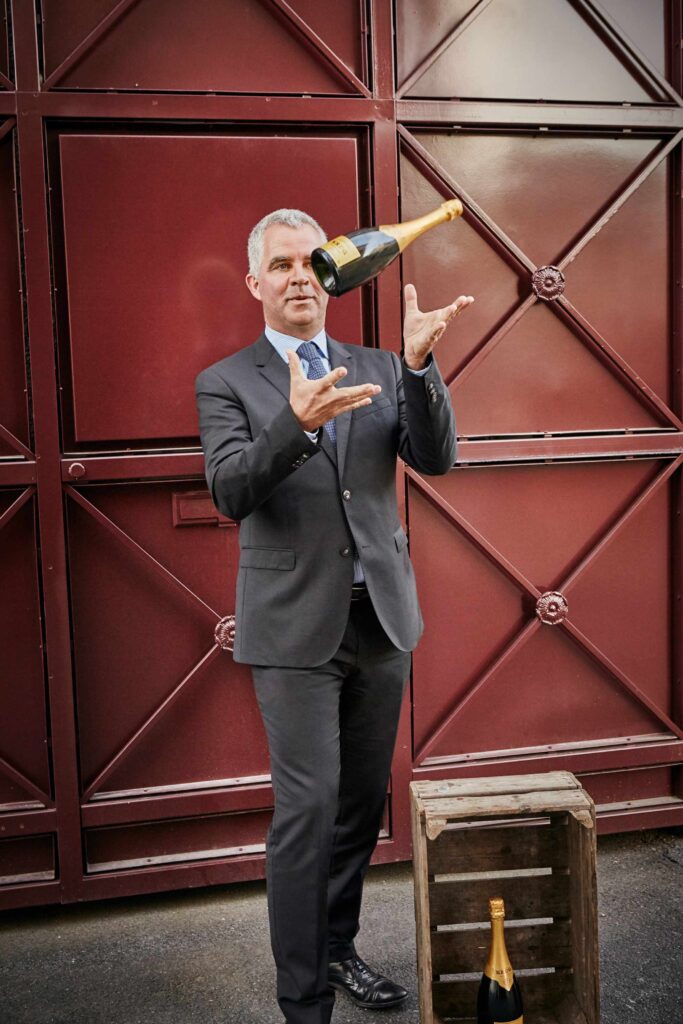
I recently had the immense pleasure and incredible chance to chat with Olivier Krug in an online Zoom interview about his “lyrical” approach to champagne zooming in on the spine-tingling details behind Krug’s iconic Grande Cuvée.
For Olivier, the Grande Cuvée (a blend of over 120 different wines from more than 10 different years) is an outstanding ensemble of top-level classically trained musicians (from session players, soloists to chamber and/or orchestral musicians) meticulously hand-picked and auditioned to harmoniously interpret the inimitable musical piece that is the quintessential reflection of the sounds, colors, pulsating notes, scents, sensibilities, and sensations composing the melody of a specific year (one specific “édition” ). The grandiose final production stems from the mind of Chef de Cave, Julie Cavil, the artistic genius and absolute maestro, who orchestrates all the magic.
As Victor Hugo said: “Music expresses that which cannot be put into words and that which cannot remain silent.”
Similarly, champagne stands as a vessel through which we experience the sensory world, allowing us to absorb the kaleidoscope of sights, sounds, scents, and tastes that envelop us.
The embodiment of epicurean pleasure, champagne, and more precisely Krug, is about enjoyments, shared moments, and the thrill of new sensations – a philosophy Olivier Krug adheres to.
Not a rule breaker, much less a rule follower, Olivier Krug is, more accurately, a poetic rule maker who, while keeping a vibrant influential pulse on the House of Krug, is forging ahead a new culture crafting the inKRUGible music of Champagne.
You are the sixth generation of the Krug Dynasty perpetuating the world-renown Krug Savoir-Faire & legacy encapsulated in a cherry-red notebook your great-great-great grandfather & founder of the house, Joseph Krug, penned. How would you define the Krug legacy?
The core idea is to offer the very best all the time which translates into creating the very best champagne every year that nature gives. To be very precise, the red notebook came as an explanation but not as a legacy. Ten years ago, I, myself, was not aware of what was in that book. I had no need to be interested in the content of the book because the Krug legacy had always been transmitted from generation to generation.
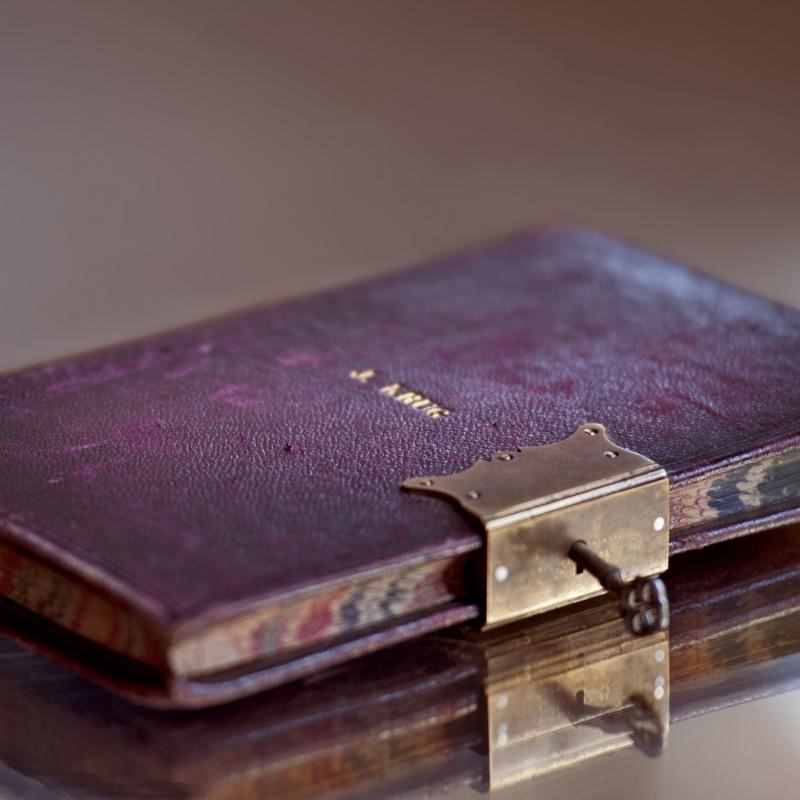
How did the focus on the Red Notebook came to be?
Ten years ago, we were a bit lost when it came to define the identity of Krug. We asked ourselves questions: Who are we? What is Krug? How can we explain Krug better? Maggie at that time asked me if I had an idea why Joseph started Krug. And actually, I had none!
We were opening boxes to find some ideas and the only few people Maggie could interview were Henri Krug, Remi Krug, Olivier Krug, and Eric Lebel. And more than likely our answers were frustrating because we never asked ourselves why and how we were here. And one day I told her about that notebook which was kept in a safe. My grandfather showed it to me in the early 1990s. This notebook has given us a mindset to dig into the past.
You catapulted the house into the 21st Century pioneering the iconic Krug ID. Can you explain what the concept is about and why it was important for you to bring more transparency to your Champagne house?
Honestly it was more Maggie Henriquez and the team’s idea than myself because I was more of the old fashion philosophy that the less we say, the better it is. I believed that the more details you give the more people will want details and loose what is the art of Krug which is pleasure.
The team argued that people today want knowledge and want to know what is behind each bottle. My understanding was very “French” in that I thought they wanted to know to judge. But I realized it was not about judging but about what Krug is all about which is generosity. It Is about “sharing”. So, we decided to share and open ourselves up. I remember one time one reporter wrote “Krug has become the benchmark of transparency among houses overnight from the darkest side of the shadow before. It was the best kept secret of Champagne.” It was fantastic but for me that was not enough because it was very technical, and I think you cannot explain Krug on the technical side. I have never told the Krug story starting with the technical explanation because Krug is not a blend.
If Krug is not a blend, then what is it?
Krug is a dream – the dream of a man. The dream of Joseph Krug who was a man who was not from Champagne, not even French and not even from a wine family. After a few years in Champagne, he told his boss (Adolphe Jacquesson) that he would leave him because he didn’t want to support his idea to offer the very best champagne every year. It’s actually a beautiful story! And the only way to make it happen was to create a type of approach that was not a classical approach in Champagne.
The Krug philosophy rests on the idea that there is no hierarchy among your champagnes only a difference of personality. Is that looking at the industry from the prism of Multi-Vintage versus Non-Vintage?
I don’t like the word “multi-Vintage”. Despite the fact that it is a word that has been created by Krug some 30 years ago, I don’t like it and I don’t use it. I think it came during an exchange with an American sommelier and my dad or my uncle. He asked them “Remi, Henri, If Krug Grande Cuvée is not a vintage or a non-Vintage then what is it?” And Remi probably explained that we were blending different plots, different years which means different vintages so it’s multi-Vintage. I think it is a very bad word and now I am training my teams to get rid of that word.
What is interesting in multi-Vintage it’s not for connoisseurs; It is maybe THE champagne for which no one needs to be a specialist because it talks so much to the senses that you don’t need to be a specialist.
What role does the reserve wine play at Krug?
The objective of the reserve wine at Krug is not to bring the past; rather it is to give some character that might be lacking that year. So, it is not about bringing age. The idea is to bring what is missing.
Each year Krug collaborate with Chefs around the world to create a tribute to Krug Grande Cuvée and Krug Rosé via a dish based around one Single Ingredient. Can you tell us more about this “Single Ingredient” initiative?
The idea started with a chat with our Chefs in Hong Kong ten years ago. We were talking about the fact that Krug is the opposite of the cliché for great champagne. Krug is not only Chardonnay and Pinot coming from the greatest years in few villages. It is about having a bit of everything wherever and whenever it comes from. It could be pinot noir from Bouzy or Ambonnay, a chardonnay from Mesnil or Avize; but it can also be a Meunier from a village which name you have never heard of; it can be a drop from a year that was not known as a good year but still have wine because we go plot by plot which allows us in some years despite the difficulty of that year to find some great wines. That’s how we have base wines from so called “bad years” because the wines were outstanding.
And so, during that conversation, the chefs realized it is the same for them. Sometimes they can cook an outstanding dish with an ingredient that would seemingly look banal. This is how we started the program. Every year we have the choice of two or three ingredients, and we call our marketing teams around the world for a vote. Over the years we went through onion, potato, rice, and this year it is lemon.
“Krug Ambassade” rallies Krug lovers around the world who, in the spirit of the Maison, passionate about Krug and commited to sharing the Krug experience with others. How does one become awarded with the “Krug Ambassade” accolade?
We have chefs around the world we call “Ambassade”. It is a natural selection. It’s very much encounters with Krug lovers. An “Ambassade” is not necessarily the place that sells the most Krug in a city. You may have a big restaurant selling a lot of Krug where no one really cares about Krug. And then you may have a smaller place where the chef, the somm, the head retailer is crazy mad about Krug and wants to spread his/her love of Krug to more people.
I love to use the example of perhaps the very first “ambassade”. It was a young man living in Reims in the suburbs with no Michelin stars. He was 26 years old and there were plenty of great and famous restaurants around and he said, “I want to be the only one to offer Krug by the glass to everyone”. I thought he was crazy, but he persistently insisted. So, I started with him in 2001 and today Arnaud Lallement is a 3-star Michelin chef and THE chef of Champagne. So, Arnaud Lallement has not been selected because he was a 3-star chef, he started with Krug as a Krug lover, as a friend of the family and the maison when he was nobody.
Joseph Krug believed that the true essence of champagne is “pleasure”. You’ve parlayed that sensation to music in the sense that both music and champagne trigger a palette of sensations. Can you expand on that ideology?
It all started in this office, which was my dad’s office, in September 1989, when he explained to me the champagne making craft as the equivalent of organizing an orchestra. He said that every year his job, like a conductor, is to identify and select musicians that he can put on stage to play a new edition, a new composition – a new edition of the most generous music of Champagne created by Joseph. I asked him if he had the same musicians every year and he said:
“of course not! I have good and not so good generation. For instance, in 2006 I had a lot of jazz musicians; it was bold, generous, and joyful. 2008 was even better but not that easy. First, I had to deal with the egos. I had to tell some of them that they were not joining the orchestra this year. Then I had to sit some of them in the orchestra and as good as they were they were not playing the most generous music of Champagne. I needed some boldness which I had in 2006. So, I called back some of the musicians I had picked in 2006.”
Evidently you’ve picked up the conductor baton and use the music analogy as your approach.
Every year I will go back and fill the empty seats with musicians whom I had asked to be patient in previous years (as far back as fifteen years ago); And every year I will have onstage a new selection of this orchestra. This has become my way of telling my story. I am not using any technical jargon or words that no one can understand if they are within the industry. And when you are part of the industry you have very little questions about Krug because you know. So the people to whom we need to be able to explain our craftsmanship are people who know very little about wine. If you speak the “wine language”, you speak a foreign language and you don’t reach them, and you lose 80% of them from the first sentence. If you use the music analogy, you will have more people embarking on the Krug experience and you will have more people developing their own expertise. This is the way we promote Krug.
And that gave birth to the Krug concept of “music pairings”?
Some years ago, we met a scientist in Oxford University who explained the connection between music and taste. And it is scientifically proven that music can change and influence the taste perception. So, we started to invite some musicians to listen to Krug. Musicians have no preconceived ideas, so they listen to the champagne and we because they do not have the wine expertise and language, we ask them to describe the experience as if it was music with their own words and their own sound. The best possible moment was just before the pandemic when Ryuichi Sakamoto agreed to embark with us on this journey.
Krug has two gems: Clos du Mesnil (Côte des Blancs) and Clos D’Ambonnay (Montagne de Reims). Knowing that the essence of a place is captured in its grapes, what is so unique about the two clos that allows Krug to craft terroir-driven champagnes?
We never acquired Clos du Mesnil. We acquired a small company in Le Mesnil sur Oger in 1971 which had a fairly large property for Champagne – more than 6 hectares. It was just impossible to miss that opportunity. Le Mesnil sur Oger offers some of the best chardonnays in Champagne. We had something like 14 -16 different plots including Clos du Mesnil. At the time no one knew about Clos du Mesnil.
Looking at the Clos my dad thought it was too big compared to others and asked to create sub-plots. And when the best wines from Clos du Mesnil went on stage for the audition alongside other wines from le Mesnil – all chardonnays – they stood out. They auditioned the wines as we do today – blind tastings, in random order, several people around the table. Everyone looked at each other and someone said “Did you hear that wine? What a violin!”; Someone else probably said “that’s beyond a violin, this must be Stradivarius”. It was a good surprise that the outstanding wines were coming from Clos du Mesnil. Year after year the wines were fantastic at such a point that my dad in 1979 decided that the Clos du Mesnil should play as a soloist.
My grandfather disapproved and said “no way Henri. We are Krug. We are the gatekeepers for blending – blending different grapes, different years, different plots -and you want to have ‘champagne de vigneron’ (grower champagne) at Krug?”
By the way in the 1970s “grower champagnes” were not the great champagnes as they are today. My dad made the experiment, and it was a success. Back then no one cared about plots and the individuality as my dad did. At Krug, since Joseph Krug, each terroir is a wine. Everyone talks about the growers, plots, and parcels today but that was in Joseph’s diary in 1848 when he wrote:
“On ne peut obtenir de bons vins sans y employer de bons éléments et des vins de bons crus. On a pu obtenir d’apparence de bonnes cuvées en employant des éléments et des crus moyens ou même médiocres; mais ce sont des exceptions sur lesquelles il ne faut jamais compter, ou on risque de manquer son opération ou perdre sa reputation.”
“One cannot obtain a good wine without using good elements and good “terroirs”. It’s possible to obtain seemingly good cuvées through the use of unremarkable or even mediocre elements and wines, but these are exceptions on which we must never rely. Otherwise, there is a risk that our process will fail or our reputation will be ruined.”
This is how we released Clos du Mesnil, which was a shock, a revolution, a scandal at the time. I remember a very famous US wine magazine publishing an article in December 1990 that featured an interview with a very famous Champenois who said that Krug had fell into the trap of marketing. No one understood what plot by plot was all about. They were used to putting all chardonnays from the same region in one big vat.
Women have and continue to play an important role at Krug. Maggie Henriquez was the first female CEO; Julie Cavil is the first female “Chef de Cave” at Krug; but before them there was another legendary female trailblazer – your personal hero – Jeanne Krug. The unsung hero, what has she contributed to the House of Krug and how important is her legacy?
I think she is more important to the family than the house. She became a legend, and she would have not liked to get the spotlight. She didn’t want people to talk about her. Even myself, I realized last year how much of a hero she was in the other war. And no one knew. Everyone is talking about the first war, but she was even more a hero in the other war. She had a role during World War I because she helped people escaped, organized life in the cellars and almost got deported.
What about Julie Cavil? When did she join the Maison?
There is one notion with Krug: it’s about patience and time. Julie joined Krug in 2006 as young promising winemaker. She was given some responsibilities and it became obvious quickly that she had the talent to one day become a Chef de Cave.
And a few years ago, Eric Lebel, who was far from retiring, felt that Julie was ready and so she became the Chef de Cave while Eric is still here. So, after 14 years Julie she became the cellarmaster. We talk a lot about 2020, the year she became the Chef de Cave, and we’re all inpatient to drink her first edition because it was the one crafted during the lockdowns. If you saw what it meant to do tastings and blending during the pandemic, it was quite an experience!
For more information visit: https://www.krug.com/

